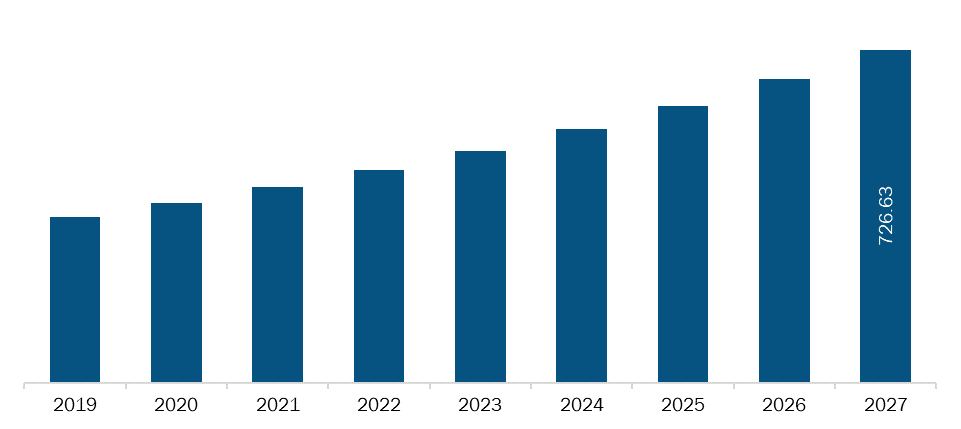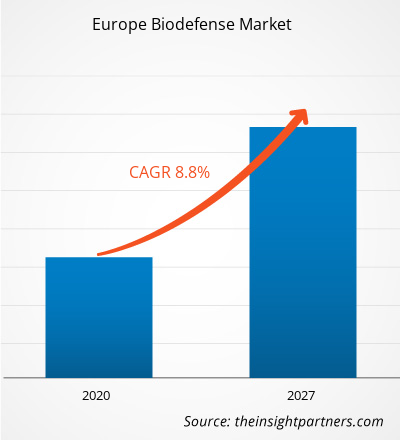The Europe Biodefense market is expected to reach US$ 1,286.58 Mn in 2027 from US$ 2,516.91 Mn in 2019. The market is estimated to grow with a CAGR of 8.8% from 2019-2027.
The growth of the Biodefense market is driven by factors such as the favorable government initiatives increase in the number of naturally occurring outbreaks, increasing threat of biological weapons and nuclear armed ICBM in the Europe region. However, fluctuations in funding due to changing EU is likely to restrain the market growth to a certain extent.
Biodefense is referred to the measures taken to restore biosecurity of a group of organisms that are, or may be, subject to biological threats or infectious diseases. It is an effective public health care system with strong disease surveillance and rapid actions designed to counter biological threats, to limit the spread of disease and provide surge medical care.
Disease outbreaks are usually caused by an infection, transmitted through person-to-person contact, animal-to-person contact, or from the environment or other media. Emerging infectious diseases are infections that have recently appeared within a population and are rapidly increasing or threaten to grow shortly. The World Health Organization warned in its 2007 report that infectious diseases are emerging at a rate that has not been seen before. Since the 1970s, about 40 infectious diseases have been discovered, including SARS, MERS, Ebola, chikungunya, avian flu, swine flu, zika, and most recently, coronavirus. In May through June 2011, a novel strain of Escherichia coli O104:H4 bacteria caused a significant outbreak of foodborne disease focused in northern Germany. In total, there were 3,950 people affected and 53 died, 51 of whom were from Germany. 800 people suffered from hemolytic uremic syndrome (HUS), which would lead to kidney failure. The growing prevalence of Ebola and Zika virus infections is also likely to contribute to the Biodefense market development. Due to coronavirus outbreak, As of 15 April, there have been 98,476 confirmed cases of COVID-19 in the UK, and 12,868 people with confirmed infection have died. Further, on March 18, 2020 Emergent BioSolutions signed development and manufacturing agreement with Vaxart for their experimental oral vaccine candidate for Coronavirus Disease.
The release of pathogenic agents such as anthrax or smallpox, biological toxins, chemical weapons such as nerve gas, or radioactive substances caused public threats in the past. In order to prevent such outbreaks, the government has planned various strategies. The growing prevalence of infectious diseases, such as coronavirus, Ebola and zika virus, is likely to boost the investments in the field of biodefense, thereby driving the Biodefense market growth.
Biological weapons (BWs) deliver toxins and microorganisms, such as viruses and bacteria, so as to intentionally inflict disease among people, animals, and agriculture. Biological attacks can result in destruction of crops, temporarily discomforting a small community, killing large numbers of people, or other outcomes. Biological weapons have a long history of use. In 1346, the invading Tartar army catapulted the bodies of plague victims into the Crimean Peninsula city of Kaffa and infected its citizens. In 1763, British troops under General Jeffrey Amherst gave the Delaware Indians blankets used by people with smallpox, possibly infecting the susceptible native population. Although recent advances in biotechnology have made it easier to develop dangerous viruses, bacteria, and toxins with fewer resources. This has increased concerns that individuals and groups could resort to bioterrorism to attack a population.
Moreover, due to factors such as increasing border threats, rising national security concerns, and changing dynamics of warfare, countries such as Russia, UK in Western Europe are inclined towards enhancing their missile weapon store. They are also modernizing their old missiles with the new propulsion system and warheads. Hence, as the threat for biological weapon and nuclear armed ICBM is increasing, governments of various countries are actively funding for biodefense, thereby, positively propelling the European market.
Rest of Europe Biodefense market Revenue and Forecasts to 2027 (US$ Bn)

- This FREE sample will include data analysis, ranging from market trends to estimates and forecasts.
EUROPE BIODEFENSE MARKET – MARKET SEGMENTATION
Europe Biodefense Market – By Product
Europe Biodefense Market – By Country
- United Kingdom
- Germany
- France
- Spain
- Italy
Companies Mentioned
- Bavarian Nordic
- Alnylam Pharmaceuticals, Inc.
- SIGA Technologies
- Emergent BioSolutions Inc.
- Cleveland Bio Labs
- Dynavax Technologies
- Elusys Therapeutics, Inc.
- Soligenix
- Altimmune
- Pluristem Therapeutics
Europe Biodefense Report Scope
| Report Attribute | Details |
|---|---|
| Market size in 2019 | US$ 2,516.91 Million |
| Market Size by 2027 | US$ 1,286.58 Million |
| Global CAGR (2019 - 2027) | 8.8% |
| Historical Data | 2017-2018 |
| Forecast period | 2020-2027 |
| Segments Covered |
By Product
|
| Regions and Countries Covered | Europe
|
| Market leaders and key company profiles |
- Historical Analysis (2 Years), Base Year, Forecast (7 Years) with CAGR
- PEST and SWOT Analysis
- Market Size Value / Volume - Global, Regional, Country
- Industry and Competitive Landscape
- Excel Dataset


- Arterial Blood Gas Kits Market
- Small Internal Combustion Engine Market
- Travel Vaccines Market
- Artwork Management Software Market
- Educational Furniture Market
- Digital Language Learning Market
- Nuclear Decommissioning Services Market
- Point of Care Diagnostics Market
- Collagen Peptides Market
- Fertilizer Additives Market

Report Coverage
Revenue forecast, Company Analysis, Industry landscape, Growth factors, and Trends

Segment Covered
Product, and Geography

Regional Scope
North America, Europe, Asia Pacific, Middle East & Africa, South & Central America

Country Scope
UK, Germany, France, Italy, Russia
Trends and growth analysis reports related to Life Sciences : READ MORE..
The List of Companies - Europe Biodefense Market
- Bavarian Nordic
- Alnylam Pharmaceuticals, Inc.
- SIGA Technologies
- Emergent BioSolutions Inc.
- Cleveland Bio Labs
- Dynavax Technologies
- Elusys Therapeutics, Inc.
- Soligenix
- Altimmune
- Pluristem Therapeutics

 Get Free Sample For
Get Free Sample For